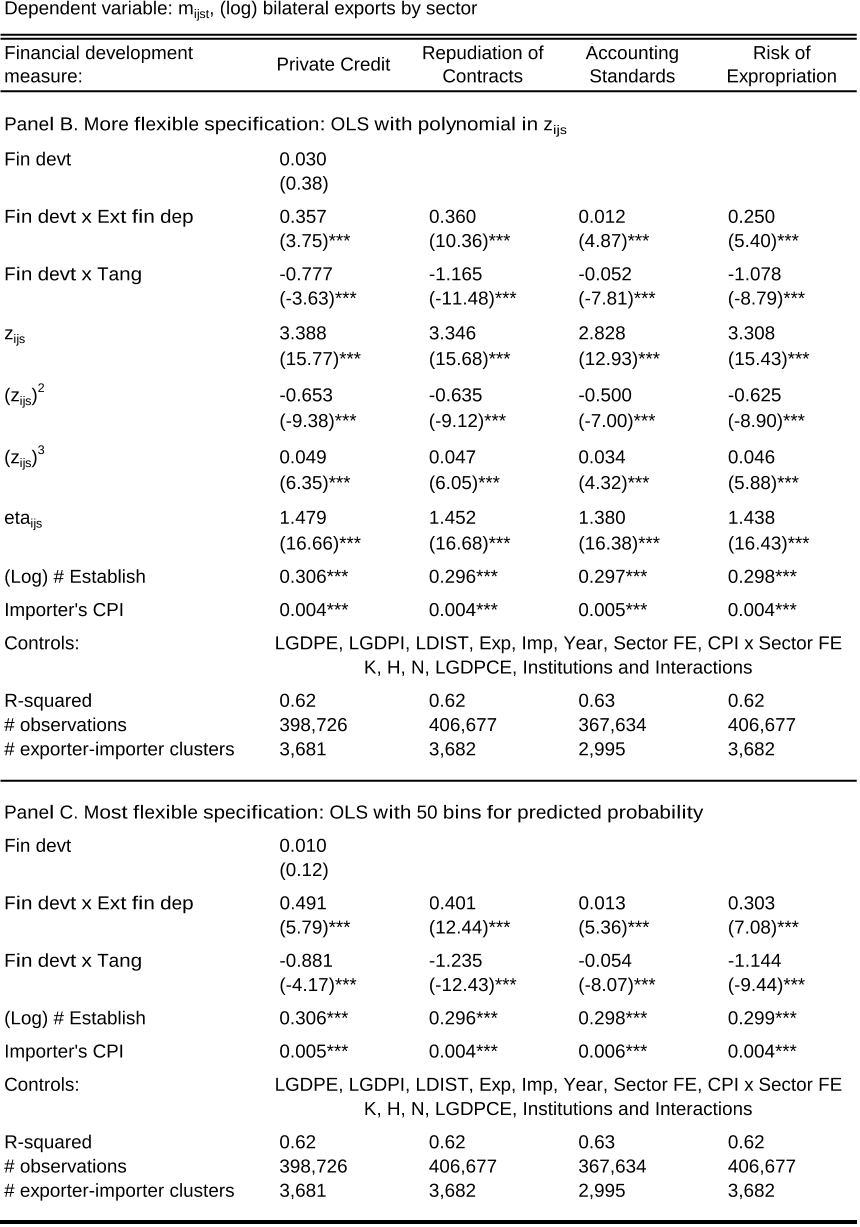Credit Constraints, Heterogeneous Firms and International Trade
Reads0
Chats0
TLDR
This article examined the detrimental consequences of financial market imperfections for international trade and developed a heterogeneous-firm model with countries at different levels of financial development and sectors of varying financial vulnerability.Abstract:
This paper examines the detrimental consequences of financial market imperfections for international trade. I develop a heterogeneous-firm model with countries at different levels of financial development and sectors of varying financial vulnerability. Applying this model to aggregate trade data, I study the mechanisms through which credit constraints operate. First, financial development increases countries' exports above and beyond its impact on overall production. Firm selection into exporting accounts for a third of the trade-specific effect, while two thirds are due to reductions in firm-level exports. Second, financially advanced economies export a wider range of products and their exports experience less product turnover. Finally, while all countries service large destinations, exporters with superior financial institutions have more trading partners and also enter smaller markets. All of these effects are magnified in financially vulnerable sectors. These results have important policy implications for less developed economies that rely on exports for economic growth but suffer from poor financial contractibility.read more
Figures

Table 10. Economic Significance: Predicted vs. Actual Trade Growth 
Table 9. Economic Significance: Comparative Statics 
Table 5. Financial Development and Firm-Level Exports 
Figure 3. The Productivity Cut-off for Exporting 
Table 5. Financial Development and Firm-Level Exports 
Table 1. Export Patterns in the Data
Citations
More filters
Journal ArticleDOI
Credit Supply and Productivity Growth
Francesco Manaresi,Nicola Pierri +1 more
TL;DR: In this article, the impact of credit constraints on manufacturers' production was studied and it was shown that an expansion in the credit supply faced by a firm increases both input accumulation and its ability to generate value added for a given level of inputs.
Journal ArticleDOI
Gravity with Zeros: Estimating Trade Potential of CIS Countries
TL;DR: In this article, the authors employ the gravity model to compare the degree of export diversification of the CIS countries relative to other countries, and show that trade flows of CIS countries are not well diversified both in terms of trading partners as well as the composition of exports.
Journal Article
Financial health, exports, and firm survival: A comparison of British and French firms
TL;DR: In this article, the authors examine the differential effects of financial status and exporting activity on the likelihood of survival for firms in the UK and France -two countries with different financial systems and find strong evidence that continuous exporters face a higher probability of survival compared to non-exporters and firms exiting the exporting market.
Posted Content
Collateral Damage: The impact of the Russia sanctions on sanctioning countries exports
Matthieu Crozet,Julian Hinz +1 more
TL;DR: In this paper, the authors evaluate the costs of sanctions in terms of export losses of the diplomatic crisis that started in 2014 between the Russian Federation and 37 countries, (including the United States, the EU, and Japan) over the Ukrainian conflict.
Journal ArticleDOI
Does Finance Play a Role in Exporting for Service Firms? Evidence from India
Sandra Lancheros,Pelin Demirel +1 more
TL;DR: The authors found that finance is not a significant determinant of Indian service firms' exporting activity and that non-financial variables such as firm size, total factor productivity and technology investments are significant factors motivating the exporting decision and the level of exports of Indian Service firms.
References
More filters
Posted Content
Law and Finance
Rafael La Porta,Rafael La Porta,Florencio Lopez de Silanes,Florencio Lopez de Silanes,Andrei Shleifer,Andrei Shleifer,Robert W. Vishny,Robert W. Vishny +7 more
TL;DR: This paper examined legal rules covering protection of corporate shareholders and creditors, the origin of these rules, and the quality of their enforcement in 49 countries and found that common law countries generally have the best, and French civil law countries the worst, legal protections of investors.
Journal ArticleDOI
Law and Finance
TL;DR: In this article, the authors examined legal rules covering protection of corporate shareholders and creditors, the origin of these rules, and the quality of their enforcement in 49 countries and found that common-law countries generally have the strongest, and French civil law countries the weakest, legal protections of investors, with German- and Scandinavian-civil law countries located in the middle.
Journal ArticleDOI
The Impact of Trade on Intra-Industry Reallocations and Aggregate Industry Productivity
TL;DR: This paper developed a dynamic industry model with heterogeneous firms to analyze the intra-industry effects of international trade and showed how the exposure to trade will induce only the more productive firms to enter the export market (while some less productive firms continue to produce only for the domestic market).
Journal ArticleDOI
Finance and Growth: Schumpeter Might Be Right
TL;DR: In this paper, the authors examined a cross-section of about 80 countries for the period 1960-89 and found that various measures of financial development are strongly associated with both current and later rates of economic growth.
ReportDOI
Financial Dependence and Growth
Raghuram G. Rajan,Raghuram G. Rajan,Raghuram G. Rajan,Luigi Zingales,Luigi Zingales,Luigi Zingales +5 more
TL;DR: This paper examined whether financial development facilitates economic growth by scrutinizing one rationale for such a relationship; that financial development reduces the costs of external finance to firms, and found that industrial sectors that are relatively more in need of foreign finance develop disproportionately faster in countries with more developed financial markets.